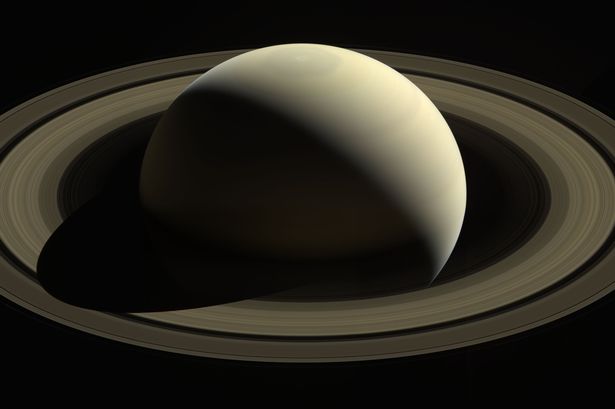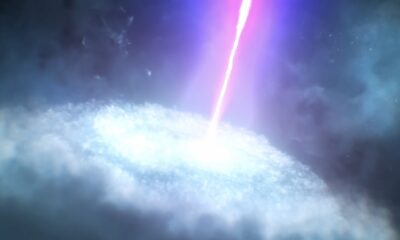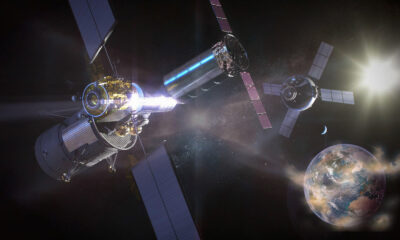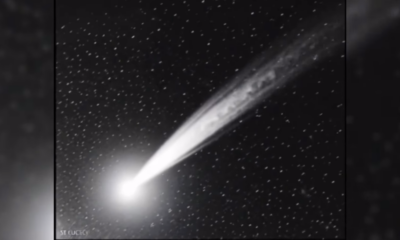Science
Saturn Dazzles as It Reaches Opposition on September 21

Saturn is set to captivate skywatchers this month as it reaches opposition on September 21, 2023. During this astronomical event, Earth will align directly between the Sun and Saturn, allowing the planet to shine its brightest and appear closest to our planet for the entire year. Observers will have a prime opportunity to see Saturn without any equipment, though a small telescope will enhance the view, revealing its stunning ring system.
NASA emphasizes the visibility of Saturn in the night sky, stating, “Saturn will be visible with just your eyes in the night sky, but with a small telescope, you might be able to see its rings.” The planet, known for its beautiful rings, will be prominently positioned in the eastern evening sky and the western early morning sky throughout September.
Historical Significance and Scientific Insights
Saturn has a rich history in astronomy. The planet’s rings were first identified as a continuous disk by Dutch astronomer Christiaan Huygens in 1655. Fast forward 325 years, and NASA’s Voyager 1 spacecraft provided groundbreaking insights into Saturn’s rings, revealing thousands of fine ringlets. Further data from the Cassini mission suggests that these rings formed approximately 200 million years ago.
The appearance of Saturn is influenced by its axial tilt of 27 degrees, which leads to seasonal changes. Its striking colors are the result of hydrocarbon hazes found above ammonia crystals in the upper cloud layers. As of June 8, 2023, Saturn boasts an impressive total of 146 moons, with additional moons awaiting confirmation from the International Astronomical Union (IAU).
Saturn’s rings themselves are believed to consist of fragments from comets, asteroids, or even shattered moons that were pulled apart by Saturn’s intense gravitational force. These rings comprise billions of small ice and rock particles, often coated with dust and other materials.
Viewing Opportunities and Celestial Events
The best time to witness planets in their brightest form occurs during opposition. During this event, Saturn will be visible for much of the night, making it a favored time for both amateur and professional astronomers. Notably, planetary oppositions for Jupiter, Saturn, Uranus, and Neptune happen almost annually as Earth orbits between these planets and the Sun.
Moreover, there are additional celestial events to look forward to in the coming weeks. NASA suggests that on September 19, early risers should watch the eastern sky just before sunrise. A conjunction involving the waning crescent Moon, Venus, and Regulus, one of the brightest stars, will create a stunning view. NASA explains, “The Moon will be nestled up right next to both Venus and Regulus. The three are part of a conjunction, which simply means that they look close together in the sky, even if they’re actually far apart in space.”
As September unfolds, enthusiasts of astronomy have much to anticipate. Whether observing Saturn’s remarkable rings or witnessing celestial conjunctions, the month promises to deliver extraordinary experiences in the night sky.
-

 World2 days ago
World2 days agoCoronation Street’s Shocking Murder Twist Reveals Family Secrets
-

 Entertainment4 months ago
Entertainment4 months agoKate Garraway Sells £2 Million Home Amid Financial Struggles
-

 Entertainment3 months ago
Entertainment3 months agoAnn Ming Reflects on ITV’s ‘I Fought the Law’ Drama
-

 Health3 months ago
Health3 months agoKatie Price Faces New Health Concerns After Cancer Symptoms Resurface
-

 Entertainment3 weeks ago
Entertainment3 weeks agoCoronation Street Fans React as Todd Faces Heartbreaking Choice
-

 World3 weeks ago
World3 weeks agoBailey Announces Heartbreaking Split from Rebecca After Reunion
-

 Entertainment5 days ago
Entertainment5 days agoTwo Stars Evicted from I’m A Celebrity Just Days Before Finale
-

 World5 days ago
World5 days agoKevin Sinfield Exceeds Fundraising Goal Ahead of Final Marathons
-

 Entertainment3 months ago
Entertainment3 months agoCoronation Street’s Carl Webster Faces Trouble with New Affairs
-

 Entertainment3 months ago
Entertainment3 months agoWhere is Tinder Swindler Simon Leviev? Latest Updates Revealed
-

 Entertainment4 months ago
Entertainment4 months agoMarkiplier Addresses AI Controversy During Livestream Response
-

 Science2 months ago
Science2 months agoBrian Cox Addresses Claims of Alien Probe in 3I/ATLAS Discovery





















